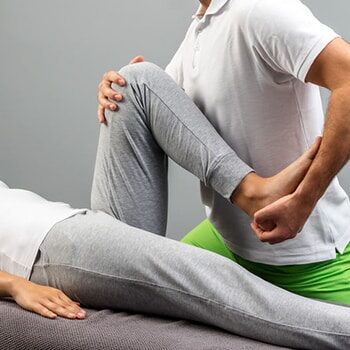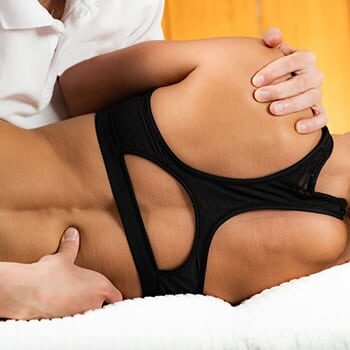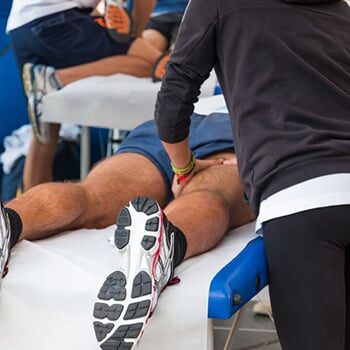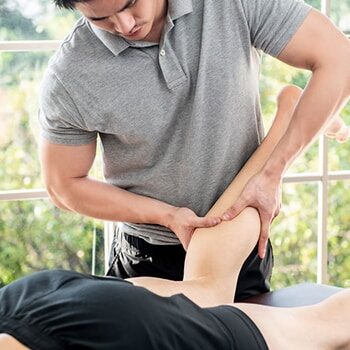
Manual Therapy

What Is Manual Therapy?
At Absolute Wellness Centers, we maximize the healing of patients through manual therapy under direct staff physician supervision. The doctor when designing your treatment regimen will write the prescription that best improves your results and helps diminish your pain and disability.
Each patient receives a specific treatment plan including goals, which will be the focus of your visit with our licensed therapists. Each of our therapists is trained in treating injuries to the spine and extremities. Some of our common goals with patients are related to improving functional limitations, increasing flexibility, and expanding your range of motion.
Whether you were injured during an auto accident, playing a sport, or a work-related incident, we are here to help alleviate your pain and discomfort.
Treatment of Sprains and Strains
Upon examination of your injury or painful condition the doctor will have a better understanding of which tissues were injured or involved. Following a trauma, soft tissues are usually stretched or torn which can lead to swelling, ecchymosis (bruising), and/or redness from inflammation and pain. This can lead to the development of adhesions and scar tissue.
Following this process there is likely the infiltration of tiny nerve fibers making the area more sensitive to the touch. Light force techniques are the usual early prescription for this kind of symptomatic presentation. Once there has been progress made and some of the adhesions have been preliminarily softened, they will be less sensitive to a deeper approach based solely on the patient tolerance. Too much, too soon may leave the patient sore for a few days.
Implementation of stretching and flexibility exercises will help you restore function. In severe cases, this process can take months to restore soft tissues to a pain free flexible state.


Manual Therapeutic Technique
Manual therapeutic techniques are any type of soft tissue treatment for the relief of pain and spasm, stress, tension, and/or to work on a specific problem area. The amount of pressure used during the therapy is dependent on patient tolerance. If a treatment is causing too much pain and discomfort it no longer is therapeutic. In our offices, our patient's healing is maximized through therapeutic techniques to decrease in pain and disability.
Manual Therapy Techniques
Our therapists are trained in various manual therapy techniques including light touch, deep tissue therapy, neuromuscular reeducation, stretching, myofascial release and trigger point therapy.
Sports manual therapy is typically more related to injuries that occur during recreational or competitive sporting activities. This leads to more focus on certain areas, muscles, or ranges of motion that are more prominently used during the actions that may have led to the injury. Deeper tissue work, focused stretching, and sometimes even instruments to are used to help achieve a deeper release level.
Manual therapy is different than massage therapy due to the types of applied pressure and strokes that are used. While massage therapy typically involves a smooth stroking of the muscles, manual therapy can better be used to target certain pressure points with deeper and more sustained contact. Another difference is that Manual therapy may involve more stretching, soft tissue manipulation, and increased joint mobilization.


Myofascial release typically increases both range of motion and flexibility through targeted positional muscle stretching. The muscle group being attended to is relaxed by putting the patient into a comfortable position so that it can be worked on. Trigger point work is then applied directly to the target areas, which maximizes muscle tolerance to the point that the brain starts relaxing your muscles. Some discomfort may be experienced initially, but once the myofascial is released, pain and stiffness begins to subside quickly.
Trigger points often occur in myofascial structures due to trauma or overuse. These pockets of inflammation can be a result of excessive muscular contractions and hypertonicity. Typically tender to the touch in the center of the muscle or at tendon attachment locations, Trigger points usually have recognizable patterns of pain when they are stretched or have direct pressure applied. Deeper pressure is often used to help treat these areas and increase the blood flow.
Following Treatment
Any time after you have soft tissue therapy you may need to rest, apply ice or heat to the areas and drink plenty of water to flush the toxins from the body. You may feel some soreness following the treatment, but this is natural in the beginning. If your soreness becomes more painful than just some soreness, please let one of our doctors know about this response so they can evaluate your situation.
For many patients, therapeutic soft tissue treatment helps relieve pain, stress, and tension and helps get you back to the activities you enjoy.

Patient Feedback:
3 Easy Steps For Manual Therapy Treatment
2. Get Adjusted
Based on your circumstances, a specific treatment plan will be implemented to correct your spine.
